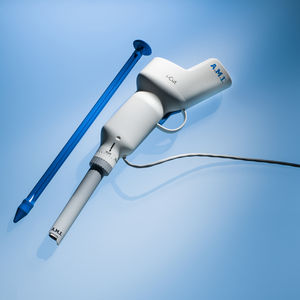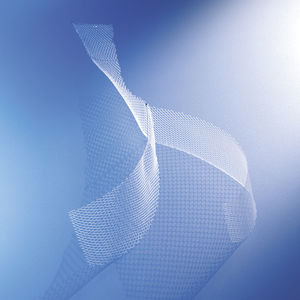
- Secondary care
- Urology
- Prolapse reconstruction mesh
- AMI - Agency for Medical Innovations
Prolapse reconstruction mesh PelviGYNiouscystocelerectocelelaparoscopic approach
Add to favorites
Compare this product
Characteristics
- Mesh type
- prolapse
- Type of prolapse
- cystocele, rectocele
- Surgical technique
- laparoscopic approach
- Patient type
- women
Description
Anterior and posterior mesh for laparoscopic sacrocolpopexy
Ultra-lightweight mesh: 21 g/m²
Highest porosity: 93%
Isoelastic with a hexagonal structure
After preparation of the vaginal vault or the cervix, the vaginal wall is mobilized. By laying the posterior mesh in the small pelvis and the anterior mesh deep under the bladder, the PelviGYNious offers a good correction of the cystocele/rectocele, as well as a tension-free apical suspension of the proximal vagina through fixation of both meshes on the sacral promontory.
Which criteria are relevant for an effective treatment of pelvic organ prolapse and for high patient satisfaction?
Long-term flexibility of vaginal tissue
Preservation of a certain apical mobility
Fast ingrowth of the mesh along with good re-collagenisation and re-vascularisation
Durable support to prevent recurrence of apical prolapse
What PelviGYNious offers:
Apical fixation to correct pelvic organ prolapse
Double-layer mesh on the proximal end for firm fixation to the os sacrum or sacral promontory with little, but existing Apex-mobility
Isoelastic single-layer mesh body around the vaginal tissue to keep flexibility of vaginal tissue as high as possible: hexagonal mesh structure, ultralight-weight mesh body
A minimum of foreign material for minimal foreign body reactions: 21 g/m²
Highest mesh porosity (93%) for mesh integration through growth of fibroblasts around the monofilaments
Catalogs
Other AMI - Agency for Medical Innovations products
Urogynaecology
Related Searches
- Reconstruction mesh
- Women reconstruction mesh
- Urinary incontinence reconstruction mesh
- Prolapse reconstruction mesh
- Vaginal approach reconstruction mesh
- Morcellator
- Cystocele reconstruction mesh
- Laparoscopic approach reconstruction mesh
- Uterine morcellator
- Colpocele reconstruction mesh
- Sphincter prosthesis
- Urinary incontinence sphincter prosthesis
- Vesical sphincter prosthesis
- Rectocele reconstruction mesh
- Hysterocele reconstruction mesh
*Prices are pre-tax. They exclude delivery charges and customs duties and do not include additional charges for installation or activation options. Prices are indicative only and may vary by country, with changes to the cost of raw materials and exchange rates.









